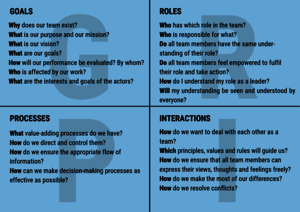#favouritemodel No. 27 - The GRIP model

When it comes to teamwork, the question of how to design the "fish tank," i.e., the context in which a team operates, becomes particularly concrete and tangible. As a manager, it is important to design the framework for action together with the team in such a way that self-organized and autonomous work becomes feasible. The model I am presenting today, "GRIP", provides a framework for this, which topics we need to cover so that there is sufficient orientation in the team and a clear picture of the common goals, roles, interactions and processes. GRIP helps us to build the guard rails within which everyone can move and develop her or his skills and competencies.
The first guardrail is the "G". It stands for "Goals", and means everything that has to do with the topic of goals. This includes the vision (of the team, the division, the company) and the mission of a team. Everything that gives orientation about the direction in which we want to move.
Guardrail two, the "R", stands for "Roles" and includes roles and responsibilities of team members. Much of this can be found in formal role and activity descriptions. But a lot of the "Who does what? Who is the contact person / expert for what?" is not documented in many teams and I have to ask around for a long time as a newcomer, for example, to get the big picture. It is also worthwhile to address and jointly reflect on social roles that develop implicitly, such as "the caretaker," "the pastor," and "the driver”.
The "I", which stands for "Interactions", refers to everything that controls and influences our interactions, such as norms and values, team rules and habits. Especially here, there are often more implicit than explicitly written down and expressed rules and habits and it is helpful to illuminate and discuss this together.
The "P" for "Processes" includes all processes within the team, but also all processes in which the team is involved, e.g. through interfaces (with other teams or departments or in the company as a whole). Here, too, it is worth taking a look at processes that have "crept in" over time. Should we stick to these and institutionalize them in a meaningful way or do they rather hinder us, limit the resources or possibilities of action of team members? About which process are there recurring misunderstandings? Where does it run smoothly and where does it bump again and again and what could be the reason for that?
How does my #favouritemodel help you?
For each of the 4 areas you can work in detail with the team and possibly fill a whole workshop day with the processing of one point. Before you discuss the GRIP dimensions together as a team, you should think about all aspects yourself:
- Where do I have clear ideas from which I do not want to deviate, and which topics do I want to define together with the team?
- What are my expectations as a manager?
- What expectations do I assume the team members have?
The discussion then moves on to a joint GRIP for the team. The exchange should leave enough room for everyone to contribute their wishes and needs. In the second step, these are then superimposed and agreements are made.
How intensively you address the 4 areas in the team, how much you as a manager already specify or only compare with your ideas after the team has worked on them - there is a lot of variability. It is clear that every team needs a basic understanding of these 4 guard rails in order to be able to work together in a targeted and coordinated manner.
P.S.: I would like to complement this text with a reference to the #favoritemodel: #No.12 "Considering the context", which focuses on so-called "problematic employees" and why it is helpful to look for reasons for "disturbing" behavior in the context (i.e. in the aquarium and not in the fish itself).











